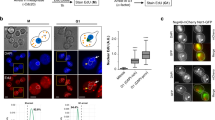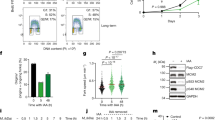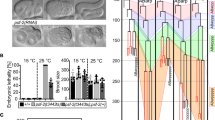Abstract
The control regulating commitment to the cell division cycle of eukaryotes seems to occur before the initiation of DNA replication1–4. In the budding yeast Saccharomyces cerevisiae, this control is called start and is the earliest gene-controlled event of the cell cycle3–5. A haploid cell which has completed start is committed to cell division and unable to undergo alternative developmental fates such as conjugation. Here, we describe an analogous start control in the fission yeast Schizosaccharomyces pombe. We have tested the ability of cdc mutants blocked at various stages of the cell cycle to undergo conjugation. Only mutants of cdc 2 and cdc 10 which block during the G1 period are able to conjugate. Other mutants which block during G1, S phase, G2 or mitosis are committed to cell division and cannot conjugate. The commitment control start is located in G1, and its completion requires the gene functions of cdc 2 and 10. Completion of start occurs at the beginning of the cell cycle in rapidly growing cells, but is delayed to later in the cell cycle at slow growth rates. The cdc 2 gene function also participates in another major cell cycle control which determines the timing of mitosis6–8. Therefore cdc 2 is a cell cycle control gene which acts at two separate points in the cell cycle: it is required in G1 for commitment to cell division and in G2 for the control of mitosis.
This is a preview of subscription content, access via your institution
Access options
Subscribe to this journal
Receive 51 print issues and online access
$199.00 per year
only $3.90 per issue
Buy this article
- Purchase on SpringerLink
- Instant access to full article PDF
Prices may be subject to local taxes which are calculated during checkout
Similar content being viewed by others
References
Prescott, D. M. Reproduction of Eukaryotic Cells (Academic, London, 1976).
Pardee, A. B., Dubrow, R., Hamlin, J. L. & Kletzien, R. F. A. Rev. Biochem. 47, 715–750 (1978).
Hartwell, L. H. Bact. Rev. 38, 164–198 (1974).
Reed, S. I. Genetics 95, 561–577 (1980).
Reid, B. J. & Hartwell, L. H. J. Cell Biol. 75, 355–365 (1977).
Nurse, P. Nature 256, 547–551 (1975).
Thuriaux, P., Nurse, P. & Carter, B. Molec. gen. Genet. 161, 215–220 (1978).
Nurse, P. & Thuriaux, P. Genetics 96, 627–637 (1980).
Egel, R. & Egel-Mitani, M. Expl Cell Res. 88, 127–134 (1974).
Crandall, M., Egel, R. & Macay, V. L. Adv. microbiol. Physiol. 15, 307–398 (1977).
Nurse, P., Thuriaux, P. & Nasmyth, K. Molec. gen. Genet. 146, 167–178 (1976).
Nasmyth, K. & Nurse, P. Molec. gen. Genet. (in the press).
Nasmyth, K. J. Cell Sci. 36, 155–168 (1979).
Jagadish, M. N. & Carter, B. L. A. Nature 269, 145–147 (1977).
Fantes, P. J. Cell Sci. 24, 51–67 (1977).
Fantes, P. & Nurse, P. Expl Cell Res. 107, 377–386 (1977).
Fantes, P. & Nurse, P. Expl Cell Res. 115, 317–329 (1978).
Nurse, P. & Thuriaux, P. Expl Cell Res. 107, 365–375 (1977).
Nasmyth, K., Nurse, P. & Fraser, R. J. Cell Sci. 39, 215–233 (1979).
Thuriaux, P., Sipiczki, M. & Fautes, P. J. gen. microbiol. 116, 525–528 (1980).
Author information
Authors and Affiliations
Rights and permissions
About this article
Cite this article
Nurse, P., Bissett, Y. Gene required in G1 for commitment to cell cycle and in G2 for control of mitosis in fission yeast. Nature 292, 558–560 (1981). https://doi.org/10.1038/292558a0
Received:
Accepted:
Issue Date:
DOI: https://doi.org/10.1038/292558a0



